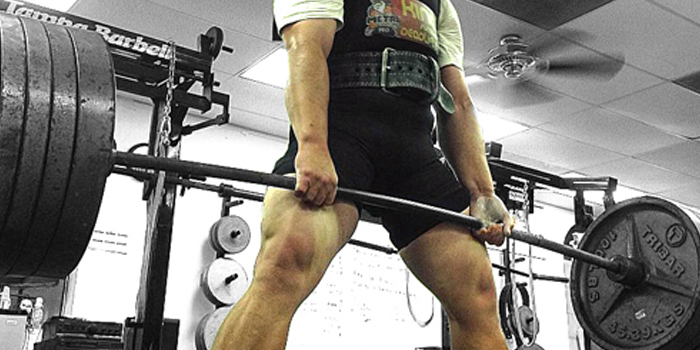
Most lifters set up their powerlifting programs in relation to the number of weeks in their current training cycle. However, this assumes that a set number of sessions will always be performed every week and that the appropriate amount of work for each lift will be guaranteed. Because most of us are in this sport as a pastime, not a profession, there aren't always a set number of sessions for each lift in any given week. In addition, some lifters may not like structuring their training over a period of seven days because it doesn’t fit their needs. Because of this, utilizing nontraditional setups may be an option.
Before we go any further, you should be familiar with the following terms:
The idea for this article came out of my current life situation. I'm now busier than I have been in the past. At one point, I was training six days a week with high frequency and set lifts that were trained on each day. While this worked at the time (during football season when I had more time), this currently isn't an option. We are now in full off-season mode, so I'm coaching and running the entire program, which is different from my limited responsibilities in-season. In addition, I have responsibilities at home and also college coursework that takes up a good deal of my time. While the high frequency approach with limited work spread over six days was fine for raw lifting, it isn't a realistic option for geared training. Because of this, I started to look for other ways to come up with a coherent plan.
I've been influenced by some programs that I've done in the past as well as by some things I found while searching for ideas. One training cycle I performed at Tampa Barbell was something that Tommy Fannon came up with. It featured a rotating schedule of high, medium and low intensity days for each lift trained in a given week. This was somewhat different than what I will outline later in this article, but all in all, it worked. Basically, this system featured low frequency work, but in a given week, a particular lift was assigned intensity. Four workouts rotated over three days in a system that I roughly remember looked like this:
Week 1
- Day 1: Squat (heavy, geared)
- Day 2: Bench (light, usually speed work or a variation)
- Day 3: Deadlift (medium, usually volume-based raw)
Week 2
- Day 1: Bench (heavy, shirted)
- Day 2: Squat (light, usually speed work or a variation)
- Day 3: Bench (medium, usually volume-based raw)
Week 3
- Day 1: Deadlift (heavy, geared)
- Day 2: Bench (light, usually speed work or a variation)
- Day 3: Squat (medium, usually volume-based raw)
Week 4
- Day 1: Bench (heavy, usually shirted)
- Day 2: Deadlift (light, usually speed work or a variation)
- Day 3: Bench (medium, usually volume-based raw)
Again, it may not have been exactly like the above, but it was similar to this. After that week, it repeats again.
This seemed to work well for certain lifts (my squat and bench responded particularly well), although other lifts weren’t as good (my deadlift didn’t fare so well on this). There are some things here that I probably wouldn’t do anymore because I don’t know how much I got out of them, but the idea of a rotating schedule and microcycle of something besides a seven-day calendar week piqued my interest again. One thing that I had wanted though was to use a higher frequency and integrate it into a block approach. The other thing I needed to consider was how to develop this to fit my needs. I plan to compete in single-ply gear this year, and on the two days that I can make it to a gym with spotters, I need to train this and still get quality work in on the days that I can’t.
The Program and Its Influence
While my programming has experienced some shifts from the earlier articles that I've written here (namely less isolation work and more of an emphasis on movements as opposed to training muscles), I knew what I wanted to accomplish. For the most part, I still wanted to develop a system that followed the principles of a “block” style system and accumulated volume earlier as well rises in intensity and specificity before tapering off at the end. The challenge was to come up with an idea that would work when gear is being introduced and make it fit with the only two days I could probably use it in a week. When my frequency was at its highest, I was integrating ideas of RTS systems such as RPE and autoregulation, but I was also utilizing frequency, intensity zones and number of lifts similar to Sheiko-influenced programs.
Upon searching, I found the programming systems of Askold Surovetsky. For those unfamiliar, this is a system that features a higher frequency of benching (three to four sessions a week but in a particular microcycle of six to eight sessions) and a rotating frequency of squatting and deadlifting (one to two sessions a week but with three sessions per microcycle). There also is a rotation of intensity in a high/low/medium fashion similar to the system outlined above, albeit with a greater frequency of certain lifts. The microcycles in this particular system are 14 days long. There are templates of this floating around the internet, but I really only used it as an inspiration for the system that I decided to design. Other than the idea of a fourteen-day microcycle, there isn’t a whole lot of similarity. Surovetsky uses more of an undulating system of intensity and volume whereas I plan to use a block-sequenced system. However, the idea of fairly high frequencies and systems with structure like this seemed like it could be tailored to my needs and preferences.
I decided to come up with a system with A weeks and B weeks. On A weeks, I plan to use gear for my squat and deadlift work and bench raw. On B weeks, it will be reversed. However, the idea is not to get caught up in the actual week because it is actually part of the same 14-day microcycle. There will be eight sessions per microcycle, which will be laid out like this in a preparatory, accumulative mesocycle:
With the second movement on sessions one, three, five and seven, the movement would be a variant of the specialized exercise that is performed with a modified tempo, an emphasized range of motion or added accommodated resistance. Sessions one, three, five and seven would be performed at a powerlifting gym with spotters. Sessions two, four, six and eight would be done either at the school weight room or another local gym with easy access. All loading will be designated by RPE and autoregulation. In general, the idea in an earlier block of training like this would be to practice the exercises with submaximal intensities, accumulate volume and work on particular weaknesses with the specialized movements.
For a microcycle later in a plan during a competitive, transmutative period, the following could be used:
At this point, directing efforts toward more similar variations of the movements of the competitive exercises themselves would take precedence. Intensity would also rise here, but the volume would drop.
On a side note, this could also be done for raw training. In that case, the exercises listed could be the same, but the notations of gear or raw would be unnecessary.
Long-Term Planning
Some people may complain and say that they will have fewer total sessions by following a schedule like this. I suggest viewing a macrocycle to get an idea of what we're dealing with. Most lifters usually spend anywhere between eight to 16 weeks prepping for a meet. Some may even choose to prep longer such as 20 weeks. If we examine a traditional seven-day microcycle, it would end up including eight to 20 microcycles. However, in the system outlined above, there are only four to 10 microcycles, depending on the setup. Of course, this really is a non-issue because there would still be the same amount of sessions. The only issue that could arise is from less geared work for a particular lift. But this may not be as much of a difference as it appears on the surface because most people would still probably only be performing a lift in gear once a week, with those who could squat, bench and deadlift multiple times in gear throughout a seven-day microcycle being the exception, not the norm.
To lay out 10 weeks of training using 14-day microcycles, we could possibly group it as follows:
Depending on how much time someone wants to set aside for a meet, this could be altered with longer accumulations/preparatory phases, transmutations/competitive phases or tapers. During tapers, the loading could feature different setups than what was outlined above, but there is some individuality to this. Possibilities include either a geared lower/raw upper week followed by the opposite to complete the microcycle or deviations from the previous setup slightly to train each lift once per week. There really isn't any correct way. The only consideration to make is to strip most other forms of work other than the competitive exercise and light rehabilitative/restorative work to allow for recovery by the competition.









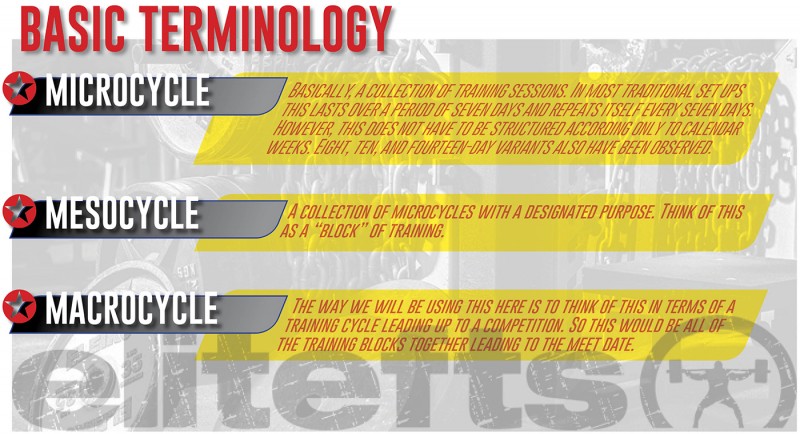
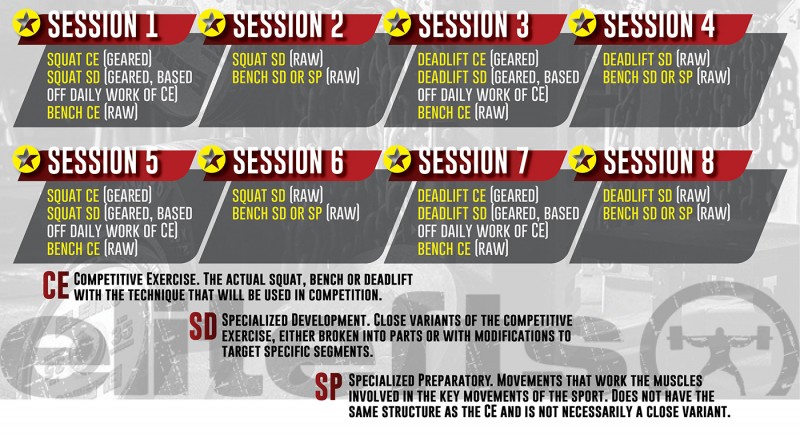
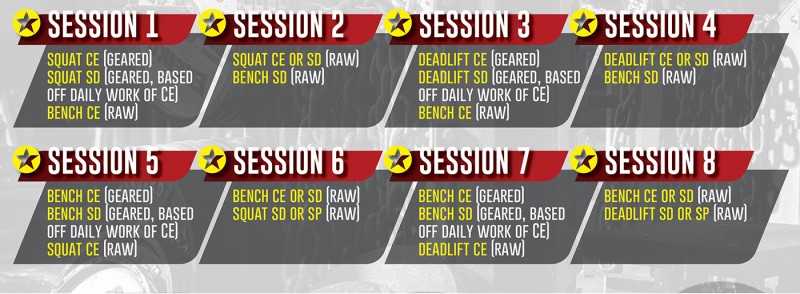
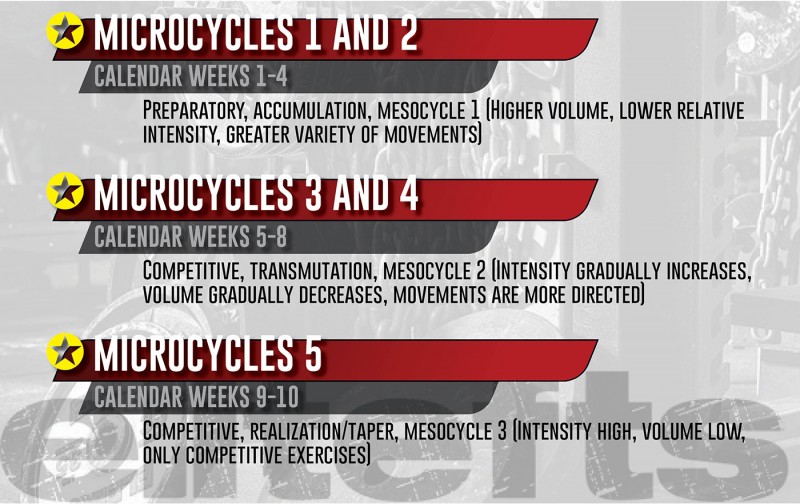


You could do it on any day but probably would want to do it on sessions 2,4,6,8. However, I am not a large proponent of excessive volumes of general work such as rows, pulldowns, etc. so I would say 2-4 sets a couple times a week would be plenty. In other styles of programming where there is a lot less volume on the competitive exercises and their variants, especially of pulling, more rowing may be necessary. However, in this particular protocol it is not, especially for an experienced lifter who has already built a base level of general preparation.